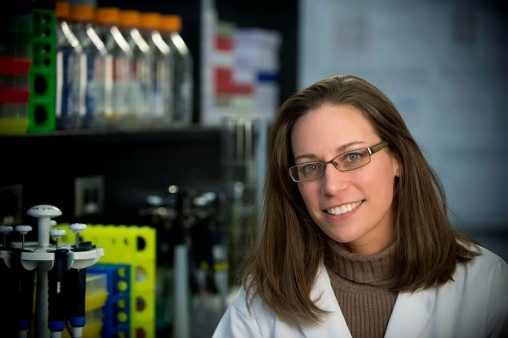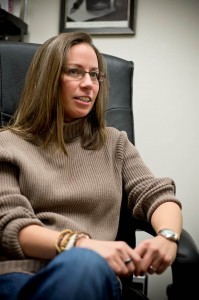
Wright State neuroscientist Debra Ann Mayes' current research focuses how to prevent and repair nerve damage from a disease that can cause behavior and developmental problems in children.
When she was 7 years old, Debra Ann Mayes found a Daddy Longlegs with a couple of legs missing. She kept it alive in the backyard of her home in the Ohio River town of Jeffersonville, Ind., feeding it flies. When the spider’s legs grew back, she was amazed.
A few years later, one of Mayes’ cousins was in shop class and accidentally cut off her finger. Surgeons in Louisville were able to sew it back together, restoring feeling and movement.
“Not too long after that, I started hearing about spinal cord patients and wondered why damaged spinal cord couldn’t grow back,” said Mayes, an assistant professor of neuroscience, cell biology and physiology. “That was a huge question for me. Everybody told me it was impossible.”
Today, the newly hired researcher at the Wright State University and Premier Health Neuroscience Institute is working on making the impossible possible.
Mayes’ current project is to find out how to prevent and repair nerve damage from a disease that can cause behavior and developmental problems in children. But her project to-do list includes research into the neurology of the brain and the circulatory, skeletal and metabolic systems.
“Everybody here is doing good hard-core science, and everybody cares about what they’re doing,” said Mayes, who arrived at Wright State in August. “To be able to work in this environment allows you to flourish. There are so many projects that I want to do.”

After suffering a stroke, Debra Ann Mayes came to realize the key role physical therapy plays in recovering from nerve damage.
Mayes obtained her bachelor degree with honors in psychology from Indiana University, carrying a heavy load of neuroscience courses. She began working on her Ph.D. at the University of Arkansas, where she helped identify a molecule that advanced knowledge about the growth of nerves in the spinal cord.
Then it happened. The 28-year-old researcher suffered a massive stroke, losing all sensation and motor movement on the left side of her body. She was rushed to the emergency room.
“I told the neurologist, ‘I’m having a stroke. These are my symptoms.’ I wasn’t all upset about it,” Mayes recalled.
“‘He said, ‘Why aren’t you hysterical?’
“I said, ‘It’s a stroke.’ It was fascinating.”
For a neuroscientist working on regeneration, having a stroke gave Mayes a window view from the inside out. During her rehabilitation, she was able to tap into the knowledge and experience of fellow patients with spinal cord injuries and also came to realize the key role physical therapy plays in recovering from nerve damage.
“It brought up things I hadn’t considered,” she said. “It added layers to my knowledge I would not have gotten.”
It took Mayes—who has since regained virtually all of her sensation and motor skills—about two months to relearn how to walk.
She returned to her lab at Arkansas and obtained her Ph.D. in neuroscience and developmental biology, doing cancer research that required learning genetics and cancer biology and biochemistry. Then she did post-doctoral work at Cincinnati Children’s Hospital Medical Center before coming to Wright State.
Mayes is currently investigating neurofibromatosis type 1 (NF1), a genetic disease that produces tumors in the nerve cells of children. NF1 can lead to autism, hyperactivity, learning and memory difficulties as well as heart and bone issues. She has discovered that antioxidants hold promise for treating the disease.
“We’re not there yet,” she said. “There’s a lot to do just on the tumor aspect.”
Because of her wide and varied experience, Mayes brings a unique expertise to the study of neurological therapy and regeneration.
“It’s one big puzzle. You have to understand each piece at a time,” she said. “As a group, we’re going to help each other put it all together.”

 Wright State MBA named one of nation’s best on-campus programs by Princeton Review
Wright State MBA named one of nation’s best on-campus programs by Princeton Review  Wright State graduate students to support underserved Ohio communities through new mental health program
Wright State graduate students to support underserved Ohio communities through new mental health program  Wright State’s Lake Campus hosts lawn party for students and community-involvement
Wright State’s Lake Campus hosts lawn party for students and community-involvement  Pioneering Wright State nursing graduate promotes cancer screenings among students
Pioneering Wright State nursing graduate promotes cancer screenings among students  Wright State University Foundation welcomes three new trustees
Wright State University Foundation welcomes three new trustees 